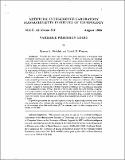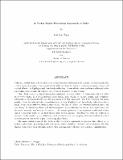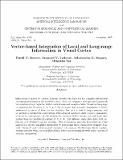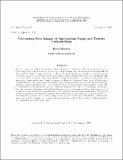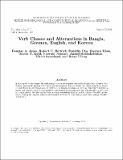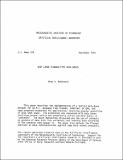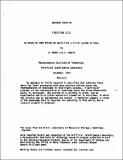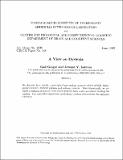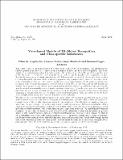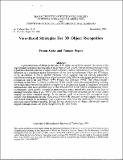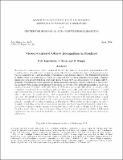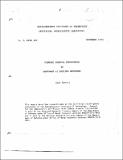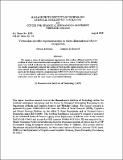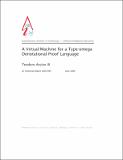Browsing Artificial Intelligence Lab Publications by Title
Now showing items 1761-1780 of 1835
-
Variable Precision Logic
(1985-08-01)Variable precision logic is concerned with problems of reasoning with incomplete information and under time constraints. It offers mechanisms for handling trade-offs between the precision of inferences and the ... -
The Variational Approach to Shape from Shading
(1985-03-01)We develop a systematic approach to the discovery of parallel iterative schemes for solving the shape-from-shading problem on a grid. A standard procedure for finding such schemes is outlines, and subsequently used ... -
A Vector Signal Processing Approach to Color
(1992-01-01)Surface (Lambertain) color is a useful visual cue for analyzing material composition of scenes. This thesis adopts a signal processing approach to color vision. It represents color images as fields of 3D vectors, from ... -
Vector-Based Integration of Local and Long-Range Information in Visual Cortex
(1996-01-18)Integration of inputs by cortical neurons provides the basis for the complex information processing performed in the cerebral cortex. Here, we propose a new analytic framework for understanding integration within ... -
Vectorizing Face Images by Interpreting Shape and Texture Computations
(1995-09-01)The correspondence problem in computer vision is basically a matching task between two or more sets of features. In this paper, we introduce a vectorized image representation, which is a feature-based representation where ... -
Velocity Space and the Geometry of Planetary Orbits
(1974-12-01)We develop a theory of orbits for the inverse-square central force law which differs considerably from the usual deductive approach. In particular, we make no explicit use of calculus. By beginning with qualitative ... -
Verb Classes and Alternations in Bangla, German, English, and Korean
(1996-05-06)In this report, we investigate the relationship between the semantic and syntactic properties of verbs. Our work is based on the English Verb Classes and Alternations of (Levin, 1993). We explore how these classes are ... -
Vertical Image Registration in Stereopsis
(1983-10-01)Most computational theories of stereopsis require a registration stage prior to stereo matching to reduce the matching to a one-dimensional search. Even after registration, it is critical that the stereo matching process ... -
Very Large Planner-Type Data Bases
(1975-09-01)This paper describes the implementation of a typical data-base manaer for an A.I. language like Planner, Conniver, or QA4, and some proposed extensions for applications involving greater quantities of data than usual. ... -
Video Ergo Scio
(MIT Artificial Intelligence Laboratory, 1973-11)An approach to vision research is described that combines ideas about low level processing with more abstract notions about the representation of knowledge in intelligent systems. A particular problem, of the representation ... -
A View on Dyslexia
(1997-06-01)We describe here, briefly, a perceptual non-reading measure which reliably distinguishes between dyslexic persons and ordinary readers. More importantly, we describe a regimen of practice with which dyslexics learn a ... -
View-Based Models of 3D Object Recognition and Class-Specific Invariances
(1994-04-01)This paper describes the main features of a view-based model of object recognition. The model tries to capture general properties to be expected in a biological architecture for object recognition. The basic module is a ... -
View-Based Strategies for 3D Object Recognition
(1995-04-21)A persistent issue of debate in the area of 3D object recognition concerns the nature of the experientially acquired object models in the primate visual system. One prominent proposal in this regard has expounded the ... -
Viewer-Centered Object Recognition in Monkeys
(1994-04-01)How does the brain recognize three-dimensional objects? We trained monkeys to recognize computer rendered objects presented from an arbitrarily chosen training view, and subsequently tested their ability to generalize ... -
Viewing Control Structures as Patterns of Passing Messages
(1976-12-01)The purpose of this paper is to discuss some organizational aspects of programs using the actor model of computation. In this paper we present an approach to modelling intelligence in terms of a society of communicating ... -
Viewpoint-Specific Representations in Three-Dimensional Object Recognition
(1990-08-01)We report a series of psychophysical experiments that explore different aspects of the problem of object representation and recognition in human vision. Contrary to the paradigmatic view which holds that the representations ... -
Views on Vision
(MIT Artificial Intelligence Laboratory, 1971-02) -
Virtual Inclusion
(MIT Artificial Intelligence Laboratory, 1983-09)Several recent knowledge-representation schemes have used virtual copies for storage efficiency. Virtual copes are confusing. In the course of trying to understand, implement, and use Jon Doyle's SDL virtual copy mechanism, ... -
A Virtual Machine for a Type-omega Denotational Proof Language
(2002-06-01)In this thesis, I designed and implemented a virtual machine (VM) for a monomorphic variant of Athena, a type-omega denotational proof language (DPL). This machine attempts to maintain the minimum state required to ... -
Virtual Model Control of a Biped Walking Robot
(1995-12-01)The transformation from high level task specification to low level motion control is a fundamental issue in sensorimotor control in animals and robots. This thesis develops a control scheme called virtual model control ...

